HITLER APPEALS TO ARMY TO SAVE CAPITAL
Berlin, Germany · April 23, 1945
On this date in 1945, with most land communications and electrical power lines down, Adolf Hitler broadcast on Greater German Radio the order to save his capital. The order called for Wehr¬macht forces opposing the Americans at the Elbe River to withdraw and move north to rescue Berlin, now within range of incessant Soviet artillery and Katyusha truck-mounted rocket fire. Two days later Hitler assured Gen. Helmuth Weidling, commanding the defense of Berlin, that reinforcements from Gen. Walther Wenck’s recently formed 12th Army and Gen. Theodor Busse’s 9th Army would deliver a crushing blow to the Bolshevik enemy. Hitler’s talk was pure fantasy and Wenck and Busse knew that. Only the night before Field Marshal Wilhelm Keitel, chief of the Supreme High Command of the German Armed Forces (OKW), had left his reclusive Fuehrer in their claustrophobic underground bunker and surprised Wenck at his headquarters, 30 miles west of Berlin. Keitel told the 43-year old Wenck—the youngest man in the Wehrmacht to hold a general’s rank—that he and Busse must lift the siege and “save Hitler.” To the agitated and irrational Keitel, Wenck merely said okay. Wenck and Busse had nowhere near the resources to accomplish anything but gather up the remains of their forces and, along with thousands of German civilians, retreat across the Elbe River and surrender to the Americans, which they did on May 7, 1945. Meanwhile, back in Berlin, the number of troops available to poor Weidling totaled around 80,000, barely enough to man the outer defense perimeter. Moreover about half of the capital’s defenders consisted of the Volkssturm people’s militia, a motley, sometimes dragooned cadre of teenagers and the elderly, many of whom lacked weapons and even basic training. The remainder consisted of exhausted and demoralized veterans of combat on the Eastern Front. Ranged against these makeshift formations were 1.5 million battle-hardened and well-equipped Soviet soldiers. On April 26 the capital’s defenders withdrew to within a few miles of Hitler’s bunker. The next day the German defense area shrank to less than 30 sq. miles. Hitler’s bunker was practically within spitting distance of the Soviets. On the night of April 29–30, a frantic Hitler, still hoping to be rescued, demanded that Keitel tell him where Armee Wenck was. In his cramped sitting room hours later Hitler put a bullet through his right temple after biting down on a cyanide capsule. His wife Eva lay slumped on the small blue-and-white couch to his left, a suicide too. Above ground nothing remained of their Thousand Year Reich.
![]()
[amazon_carousel widget_type=”ASINList” width=”600″ height=”200″ title=”Recommended Reading” market_place=”US” shuffle_products=”False” show_border=”False” asin=”0142002801,0099551896,030759582X,1906033129,184884381X,0143122134,1844159353,0312614926,1782741356,0316035998″ /]
Scenes of Devastation from the Battle in Berlin, April 23–May 2, 1945
 | 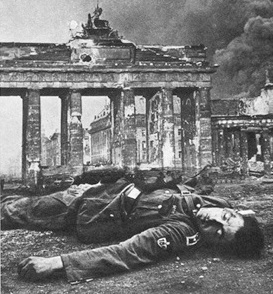 |
Left: The German Reichstag shows the scars of battle. Forces defending the Nazi symbol of power included naval, SS, and Hitler Youth personnel. Many defenders held out in the building’s upper floors and cellars. It took several hours of vicious room-to-room fighting before Red Army personnel secured the building.
![]()
Right: A dead NCO lies close to the Brandenburg Gate while smoke rises from the nearby Reichstag. The badge on his sleeve indicates membership in an unidentified formation numbered 185. Death, devastation, and smoke cast a pall over the Reich capital that lasted for weeks.
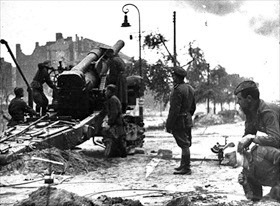 | 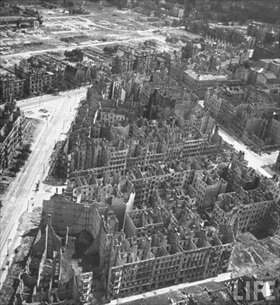 |
Left: Forty thousand Soviet artillery guns hammered the Nazi capital around the clock. The caliber of guns the Soviets brought to bear on Berlin’s streets increased rapidly. Capable of firing one shell every two minutes, 203mm howitzers like this one had a range of 10 miles and a crew of 15.
![]()
Right: An aerial photo of Berlin shows the legacy of destruction left by the war. By April 1945 Berlin had become a moonscape of ruined buildings and cratered streets.
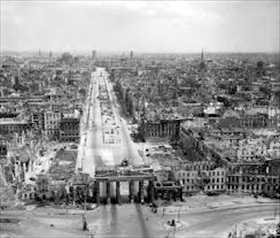 | 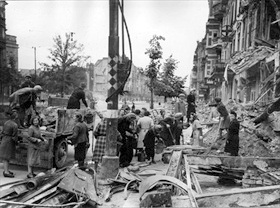 |
Left: Berlin’s premier street Unter den Linden in 1945 presented a grim contrast with the street’s prewar splendor. View is to the east.
![]()
Right: Berliners had learned to clear streets following Allied bombing raids in the early days of the war. During the Battle of Berlin, many streets and sidewalks were turned into rubble-fields and thousands of citizens were conscripted afterwards to make them passable.
Berlin 1945: A Cavalcade of Photos from German and Soviet Archives
![]()

 History buffs, there is good news! The Daily Chronicles of World War II is now available as an ebook for $4.99 on Amazon.com. Containing a year’s worth of dated entries from this website, the ebook brings the story of this tumultuous era to life in a compelling, authoritative, and succinct manner. Featuring inventive navigation aids, the ebook enables readers to instantly move forward or backward by month and date to different dated entries. Simple and elegant! Click
History buffs, there is good news! The Daily Chronicles of World War II is now available as an ebook for $4.99 on Amazon.com. Containing a year’s worth of dated entries from this website, the ebook brings the story of this tumultuous era to life in a compelling, authoritative, and succinct manner. Featuring inventive navigation aids, the ebook enables readers to instantly move forward or backward by month and date to different dated entries. Simple and elegant! Click 











